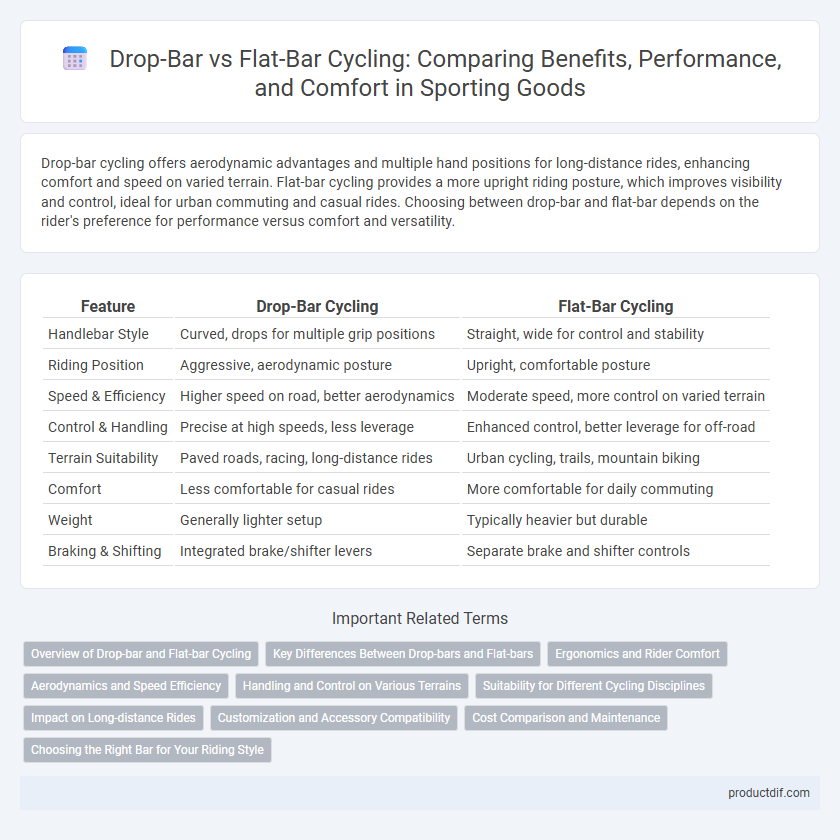Drop-bar cycling offers aerodynamic advantages and multiple hand positions for long-distance rides, enhancing comfort and speed on varied terrain. Flat-bar cycling provides a more upright riding posture, which improves visibility and control, ideal for urban commuting and casual rides. Choosing between drop-bar and flat-bar depends on the rider's preference for performance versus comfort and versatility.
Table of Comparison
| Feature | Drop-Bar Cycling | Flat-Bar Cycling |
|---|---|---|
| Handlebar Style | Curved, drops for multiple grip positions | Straight, wide for control and stability |
| Riding Position | Aggressive, aerodynamic posture | Upright, comfortable posture |
| Speed & Efficiency | Higher speed on road, better aerodynamics | Moderate speed, more control on varied terrain |
| Control & Handling | Precise at high speeds, less leverage | Enhanced control, better leverage for off-road |
| Terrain Suitability | Paved roads, racing, long-distance rides | Urban cycling, trails, mountain biking |
| Comfort | Less comfortable for casual rides | More comfortable for daily commuting |
| Weight | Generally lighter setup | Typically heavier but durable |
| Braking & Shifting | Integrated brake/shifter levers | Separate brake and shifter controls |
Overview of Drop-bar and Flat-bar Cycling
Drop-bar cycling features handlebars that curve downward, providing multiple hand positions and an aerodynamic riding posture favored by road cyclists and long-distance riders. Flat-bar cycling uses straight handlebars that offer better control and stability, making it popular among mountain bikers and urban commuters for improved maneuverability and comfort. Each handlebar type influences rider posture, control, and efficiency, catering to different cycling styles and terrains.
Key Differences Between Drop-bars and Flat-bars
Drop-bar cycling offers multiple hand positions and aerodynamic advantages, making it ideal for long-distance and road cycling. Flat-bars provide a more upright riding posture, enhancing control and comfort, which is preferred for urban commuting and mountain biking. Key differences include drop-bars' focus on speed and efficiency versus flat-bars' emphasis on maneuverability and stability.
Ergonomics and Rider Comfort
Drop-bar cycling offers multiple hand positions that reduce wrist strain and improve aerodynamics, enhancing rider comfort during long rides. Flat-bar cycling provides a more upright posture, which alleviates lower back pressure and increases control, benefiting casual or urban riders. Ergonomic considerations favor drop bars for performance-oriented cycling and flat bars for relaxed, injury-free rides.
Aerodynamics and Speed Efficiency
Drop-bar cycling offers superior aerodynamics by allowing riders to adopt a lower, more streamlined position, reducing air resistance and improving speed efficiency on flat and downhill terrains. Flat-bar cycling provides a more upright stance that prioritizes comfort and control but increases drag, leading to reduced aerodynamic efficiency and slower speeds over long distances. Competitive cyclists favor drop bars for enhanced speed performance, while flat bars are preferred for casual riding and urban environments where maneuverability is key.
Handling and Control on Various Terrains
Drop-bar cycling offers enhanced aerodynamics and multiple hand positions, providing superior handling and control on varied terrains such as steep climbs and fast descents. Flat-bar cycling delivers a more upright riding posture, improving visibility and stability, which is advantageous for technical trails and urban environments. Choosing between drop-bar and flat-bar setups depends on terrain complexity and rider preference for precision handling versus comfort and control.
Suitability for Different Cycling Disciplines
Drop-bar cycling suits road racing and long-distance endurance riding due to its aerodynamic position and multiple hand placements that reduce fatigue. Flat-bar cycling is optimized for urban commuting, mountain biking, and casual rides, offering better control and maneuverability. Each handlebar type aligns with specific cycling disciplines, maximizing performance and comfort based on terrain and riding style.
Impact on Long-distance Rides
Drop-bar cycling enhances aerodynamics by allowing riders to adopt a lower, more streamlined position, reducing wind resistance and conserving energy on long-distance rides. Flat-bar cycling offers a more upright posture, promoting comfort and better control, which may benefit riders not prioritizing speed but enduring prolonged hours. Choice between drop-bar and flat-bar setups significantly influences rider fatigue, muscle engagement, and overall efficiency during extensive cycling sessions.
Customization and Accessory Compatibility
Drop-bar cycling offers extensive customization options with multiple hand positions and compatibility with a wide range of road-specific accessories such as aero bars, integrated shifters, and clip-on lights. Flat-bar cycling provides easier access to handlebars and simplifies mounting accessories like mirrors, GPS devices, and bell systems, prioritizing practical everyday use. Both handlebar types support different accessory arrangements tailored to the rider's preferences and cycling style.
Cost Comparison and Maintenance
Drop-bar cycling bikes generally have higher initial costs due to more complex components like integrated shifters and specialized brake systems, while flat-bar bikes are more budget-friendly with simpler setups. Maintenance expenses for drop-bar bikes tend to be higher because of their intricate cable routing and component sensitivity, whereas flat-bar bikes require less frequent and simpler upkeep. Choosing between the two often depends on balancing performance preferences with long-term cost efficiency.
Choosing the Right Bar for Your Riding Style
Drop-bar cycling offers aerodynamic advantages and multiple hand positions ideal for long-distance and high-speed road riding, enhancing comfort and control. Flat-bar cycling provides a more upright posture, better visibility, and easier maneuverability, well-suited for urban commuting and casual rides. Selecting the right bar depends on your riding style, terrain, and desired comfort level, ensuring optimal performance and enjoyment.
Drop-bar cycling vs Flat-bar cycling Infographic

 productdif.com
productdif.com